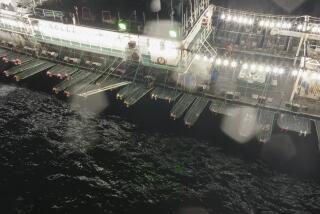‘In Murmansk you had the worst of the submarines and the worst of the weather.’ : A Spiritual Return to Murmansk
- Share via
The last time Richard Connelly left for the Soviet port of Murmansk, the Nazis sank his supply-laden ship in the North Atlantic.
Last week, the retired Long Beach merchant seaman set out again, this time to honor his fellow mariners who died transporting war materiel to the frigid Soviet port during World War II.
Connelly and about 15 other seamen, joined by friends and relatives, left Los Angeles International Airport for a tour of the Soviet Union, which will include a visit this week to the Arctic Circle city where hundreds of merchant mariners delivered everything from Jeeps to Spam to the battered Red Army.
The Murmansk run, as the Allied convoys were called, was one of the most perilous for the civilian merchant mariners, who were usually escorted to the port by the British navy or the Soviet North Fleet. Because of the course of the warm Gulf Stream, the Barents Sea port was ice free even during the winter, making it one of the only reliable entryways to the Soviet Union--but also a favorite target of the Germans.
Hundreds of seamen bound for Murmansk were killed when their convoys were picked off by Nazi U-boats and bombed by the Luftwaffe. Others died during German attacks on the city or perished from the bitter cold.
“In Murmansk, you had the worst of the submarines and the worst of the weather,” said Connelly, who made a successful run there in 1942 but was sunk during a second try a year later. “They had some of the worst fighting up there. You would receive 18 to 20 air raids a day.”
The American seamen, who will be the guests of Soviet mariners in both Leningrad and Murmansk, will visit a little-known cemetery in Murmansk where merchant mariners from the United States and several other countries who fought alongside the Soviets are buried.
The group will hold what they believe to be the first memorial service by Americans at the graveyard. They have also taken along a plaque honoring the dead seamen, which they hope to place at the cemetery.
“It is a spiritual journey for those who survived the Murmansk run,” said the Rev. Arthur Bartlett, pastor of the Episcopal Seamen’s Church Institute in San Pedro, who will preside over the service. “It will be a spiritual renewal for them.”
While hundreds of seamen are known to have died in or near Murmansk, no one is certain how many Americans are actually buried there. Many victims of the war were interred in unmarked or common graves, buried or lost at sea or sent back to the United States.
But the American group knows that there are at least two marked American graves in the cemetery.
The chairman of the executive committee of the Murmansk City Council, Vladimir Gorachkin, wrote to San Pedro seaman Joe Goren that there are 29 foreign graves in the cemetery, including 2 Americans, 2 Canadians, 13 Britons, 5 Arabs and 1 Chinese. A merchant seaman who visited Murmansk during a ski trip several years ago also mentioned in a seamen’s newsletter that he saw two American graves.
Members of the American tour, organized by the Los Angeles area chapter of the American Merchant Marine Veterans, said they hope to track down friends who died on the Murmansk run.
“I know several guys who were killed when our convoy was hit,” said Donald Gibbs, a real estate broker in Mesa, Ariz., who spent four months in Murmansk during the winter of 1944. “I would like to see if I can find them.”
The American seamen will return to Murmansk on the 45th anniversary of one of the worst merchant marine disasters of the war. In July, 1942, a convoy of 35 merchant ships en route from Iceland to Murmansk ran into the German navy. The PQ-17 Convoy, as it was known, lost 24 of its ships, 153 men and 140,000 tons of cargo--including 200 aircraft, 400 tanks and 3,300 vehicles.
While none of the seamen returning to Murmansk was part of that convoy, William Schwab, a seaman from Wilmington, said that does not matter.
“I had friends who were on those ships, and no one has paid tribute to them,” Schwab said. “I am saying to them, ‘I still remember you, even though nobody else may remember you.’ ”
But not all survivors of the Murmansk run jumped at the chance to return. Philip Proctor, a retired merchant mariner who lives near San Diego, said he boycotted the trip because the U.S. government has denied merchant seamen veteran status.
“I have never gotten any benefits or anything for what I have done for this country,” said Proctor, who spent three winter months in Murmansk trapped by German U-boats. “The government should be sending us back on a good will mission to recognize the merchant seamen who died there. For me to go back now, and pay my own way, would be disgraceful.”
While the other seamen joined in calling for government recognition of merchant marine veterans, they said their return trip has an even greater significance.
“I am pretty happy to be alive,” Gibbs said.
More to Read
Sign up for Essential California
The most important California stories and recommendations in your inbox every morning.
You may occasionally receive promotional content from the Los Angeles Times.










